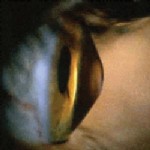Gender differences in patients with keratoconus have been found in patient history, vision and ocular symptoms, says a study in Septembers American Journal of Ophthalmology. Two interesting findings: Women with keratoconus were more likely than men to report ocular dryness, and women were more likely to visit an eye doctor.
 |
| Women with keratoconus are more likely than men to report ocular dryness symptoms. |
Researchers found the following gender differences regarding patient history:
Women with keratoconus were older than men.
Women were more likely than men to report a family history of keratoconus.
Women were more likely than men to be nonwhite.
Women were less likely than men to complete college.
One visual characteristic varied between men and women: More men had Vogts striae than women.
Researchers found the following gender differences regarding ocular symptoms:
Women were more likely than men to report ocular dryness.
Women reported more hours per day of near work and were less likely to report the ability to wear contact lenses for enough hours to permit reading at home in the evening.
Women reported more visits to their eye care practitioner during the previous 12 months.
The most interesting results are arguably the increased frequency of dryness symptoms and increased visits to eye care practitioners, says optometrist Karla Zadnik, chairperson of the CLEK study. Practitioners may find these data useful in everyday care of keratoconus patients.
Fink BA, Wagner H, Steger-May K, et al. Differences in keratoconus as a function of gender. Am J Ophthalmol 2005 Sept;140(3):459-68.

